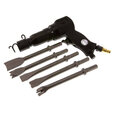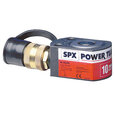What Is a Chisel? Types And Uses Of Chisels
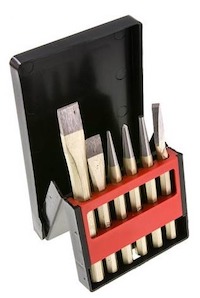
Figure 1: Chisel set
Chisels are cutting tools with sharpened edges at the end of metal blades. They come in different types, shapes, designs, styles, and sizes to fit different purposes. The choice of a chisel type mainly depends on the workpiece. A chisel is a powerful tool in woodwork, metalwork, and masonry. This article explores the main types of chisels, how to use them, and the different materials chisels can work with.
Table of contents
- What is a chisel
- Types of chisels
- Hammered chisels
- Non-hammered chisels
- What materials can chisels work with?
- FAQs
View our online selection of air hammers & chisels!
What is a chisel
A chisel is a cutting tool with a characteristically sharpened metal edge. The metal forms the cutting blade or edge at one end. Chisels cut, sculpt, scrape, or shape stone, wood, and metal. They have a handle on the opposite side of the cutting edge to allow the operator a firm grip with one hand while striking with the other using a hammer. The chisel’s cutting edge or the sharpened blade comes in different shapes, designs, and sizes to generate a variety of cuts or grooves on the workpiece as desired. The edge penetrates the workpiece (metal, wood, or stone) as one directs force by hand, mallet, or hammer (electric/pneumatic). Pneumatic and electric hammers are handheld tools for chiseling that provide fast, smooth, and accurate cutting compared to manual hammers.
Types of chisels
Chisels come in different shapes and sizes, giving a wide array to choose depending on the working material. Chisels classification is based on the work for which they are designed. They are broadly categorized into three classes: wood, metal, and stone. Within these three classes, numerous sizes and cutting-edge shapes are designed for different cutting, scraping, and shaping purposes. They can also be identified according to how they are operated: those that need hammering and those that shouldn't be hammered.
Hammered chisels
Hammered chisels work with a hammer or mallet. Chisels that require hammering tend to have thicker and tougher blades to withstand a higher force. The handles have a flat head designed to be struck by a hammer. The various types of chisels that require hammering when working on metal, wood, or stone and their applications are discussed below.
Bevel-edged chisel
The bevel-edged chisel is a strong chisel that is neither too long nor too short. It has a beveled or angled side and a straight edge. The beveled and straight edges allow maximum access to dovetail joints and make it easier to access corners.

Figure 2: Bevel-edged chisel
Bench chisel
Bench chisels are shorter than bevel-edge chisels and are strong chisels fitted with a tang or socket. A hoop at the top that enables the maximum amount of energy to reach the cutting edge when struck with a hammer. They are ideal for chopping, paring, trimming, and joinery in furniture work.
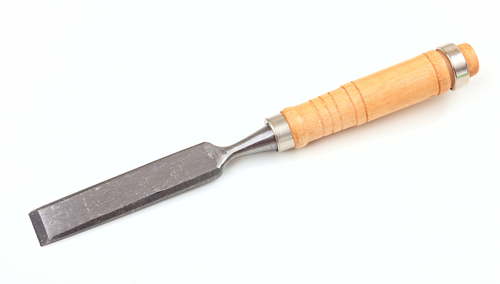
Figure 3: Bench chisel
Firmer chisel
Firmer chisels, as the name suggests, comprise hard material like steel for use in heavy-duty work. They are one of the oldest chisel models. They have a blade with a rectangular cross-section and a 20-degree bevel. Due to their shape, they are ideal for creating incredibly sharp 90-degree corners. The handle of a firmer chisel comprises hardwood or hardened plastic to withstand the strikes of a hammer or mallet.
Mortise chisel
A mortise chisel cuts deep mortise joints. The chisel comprises a heavy blade that is thicker than its width. The blade consists of huge forged bolsters to prevent bending when hammering. The handle of a mortis chisel comprises hardwood, capped, or steel hoops to withstand pressure and repeated heavy striking. The chisel's head is typically cut to an angle between 30 and 40 degrees. Due to their design, they are long-lasting and can withstand repeated hammer strikes. They are ideal for chopping out joints and levering out waste woodwork.
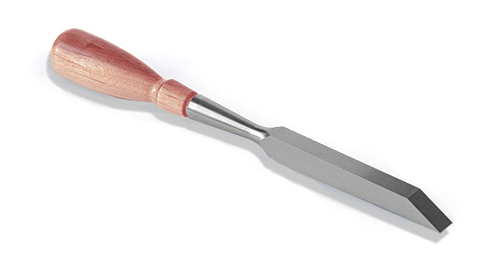
Figure 4: Mortising chisel
Bolster chisel
Also known as a brick chisel, a bolster chisel cuts straight lines into bricks, metal, or stones. They have a flat handle and a strong beveled edge blade that will cut through most hard materials at the strike of a hammer or mallet.
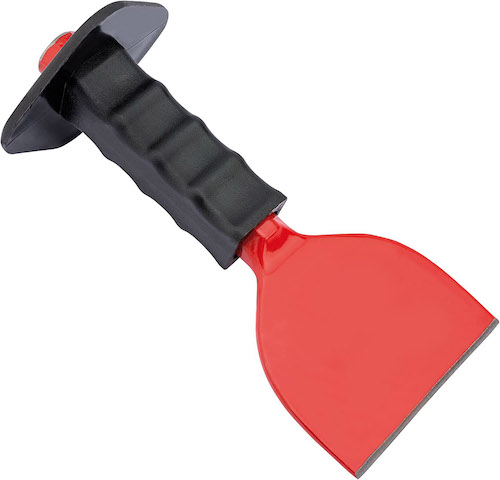
Figure 5: Bolster chisel
Butt chisel
A butt chisel has a uniquely short blade. It derives from firmer or bench chisels and has both beveled and straight cutting edges. These are excellent for installing butts and hinges in carpentry. Also, they are useful when working in hard-to-reach or cramped areas of a workpiece.
Concrete chisel
A concrete chisel breaks up concrete floors, sidewalks, and paving slabs. It comprises a large striking area and a head design that reduces mushrooming.
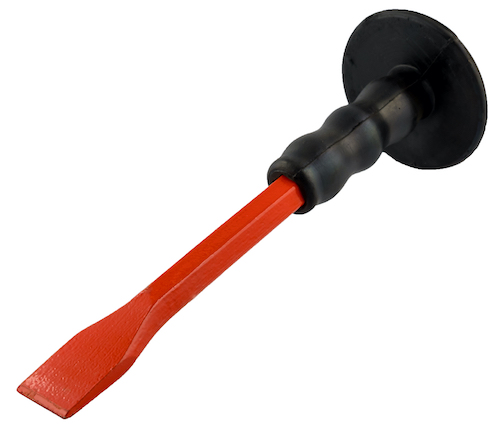
Figure 6: Concrete chisel
Cold chisel
A cold chisel cuts through and shapes hard materials likecold metal in which the stock is thick and other tools like hacksaws, shears, and tin snips are unsuitable. The descriptor cold means that metal is not preheated before using the tool. Cold chisels are typically tempered carbon tool steel, making them hard enough to get through metal and masonry. The cold chisel can be of various types like flat, cape, round-nose, and diamond-pointed chisels. Read our article on cold chisels for more information on the design and applications of cold chisels.

Figure 7: Cold chisel set
Other chisels that require hammering include round, cape, framing, and corner chisels.
Non-hammered chisels
The most common chisel that doesn't require hammering is atang chisel. They include the following types.
Paring chisel
The paring chisel has a light, thin blade and a cutting edge with a bevel ground at a 15 degree angle. The blade tends to be longer than those of firmer chisels, and the handle is different. A paring chisel is for light work and therefore isn't designed to be struck with a hammer or mallet.
Dovetail chisel
Dovetail chisels create dovetails and finish joints. They feature a long blade and cutting edge with beveled edges at 20-30 degrees. Due to their long length, they are ideal for cleaning out and sharpening joints.
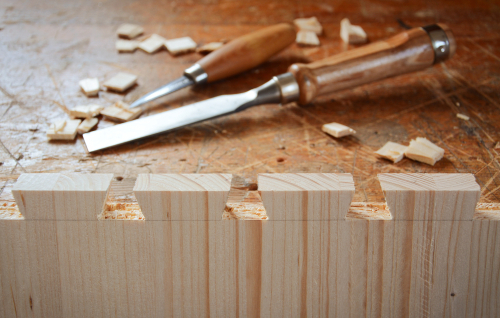
Figure 8: Chisel used to create a dovetail joint
Slick chisel
The slick chisel works almost the same as a paring chisel but with a broader and straighter blade. They have a distinct baseball bat-shaped handle for a comfortable grip when paring off thin pieces of wood from the woodwork.
Power chisel
An electrical grinder motor powers the power chisel and does the work of a hammer. These are quicker and more efficient than other conventional hand-held chisels.
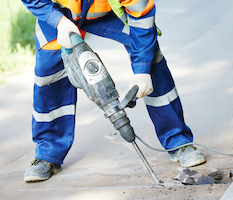
Figure 9: An electric hammer with a chisel.
What materials can chisels work with?
Chisels are also categorized according to the materials they work with. Whether they require hammering or shouldn't be hammered, they can work on wood, metal, or stone.
- Wood Chisel:Wood chisels are for carpentry or furniture work. They include bevel-edged, butt, framing, mortise, dovetail, corner, skew, parting, Japanese, carving, and flooring chisels.
- Metal Chisel: Cold and hot chisels are the two main chisel types that shape and cut metals. Cold chisels work on unheated metal by hammering, while hot chisels work on metal softened by heat from a forge or torch.
- Stone Chisel: Stone chisels are used in masonry to cut, shape, and scrape stones and bricks. They include standard and toothed stone chisels, masonry chisels, spoon chisels, and brick bolsters. Read our article on masonry chisels for more information on how to use masonry chisels.
FAQs
What is a chisel, and what does it do?
A chisel cuts, sculpts, scrapes, or shapes stone, wood, and metal by hammering, manual pushing, electric power, or pneumatic machinery.
What materials comprise chisels?
Steel comprises almost all chisel types. Hardened or carbon steel comprise cold chisels This enables them to withstand repeated hammer strikes and increase their lifespan. Some of them, especially those that don't require hammering, are comprised of aluminum bronze or beryllium copper.
How do I sharpen a chisel?
To sharpen a chisel, you'll need a sharpening stone (oil or water stone), honing guide, safety glasses, leather gloves, and a dust mask.




